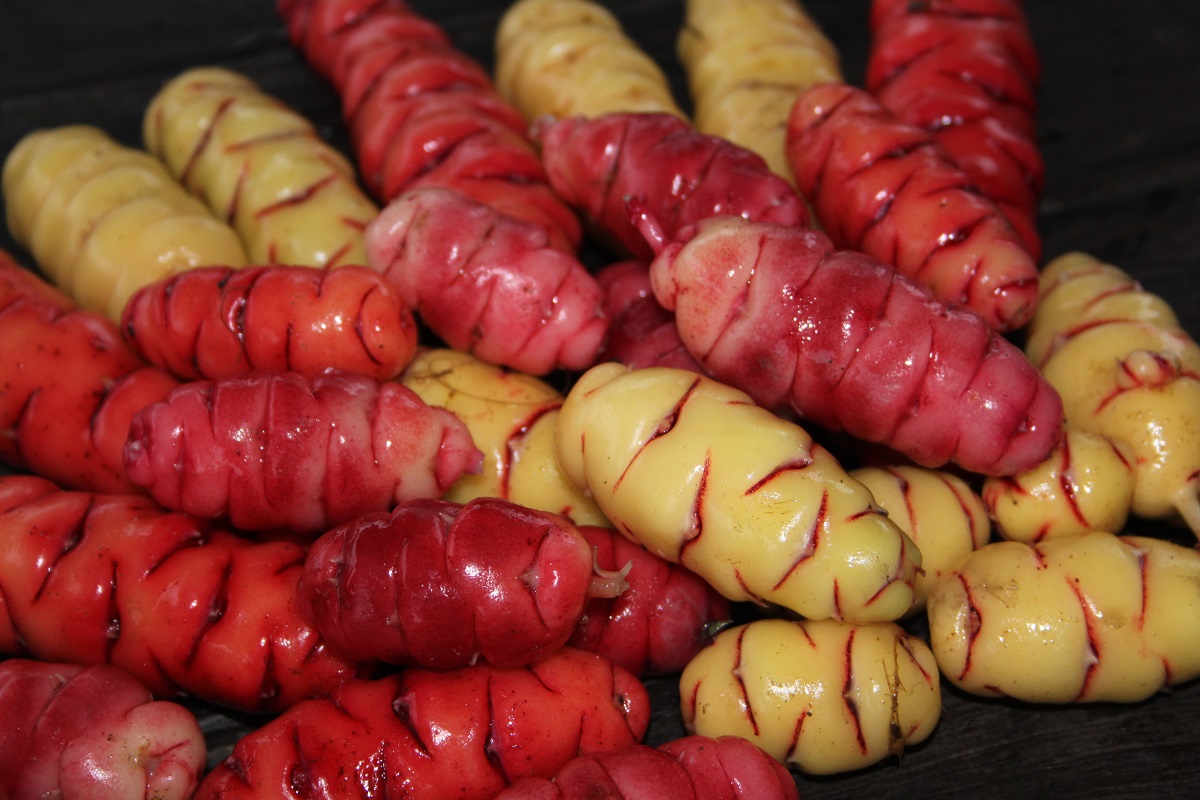(ARTICHOKES / ALPINE STRAWBERRY / YACON / WATER CHESTNUTS ETC. )
Please note not everything in this category is available each year.
ALPINE STRAWBERRIES
Upon receipt please unpack and plant individual plants into pots to grow on for a while before planting out into permanent positions.
Clump forming strawberries that do not form runners. For posting the larger leaves were removed to keep the plant in good condition. Plant into well prepared, fertile, soil. Likes to be mulched. Can grow in full sun or light shade – in very hot areas seems to do better in light shade. Great as edging plants in the garden. Clumps can be dug up and divided each year to increase stock.
ARTICHOKES – Jerusalem, Dalmatian and Red Skinned
Upon receipt please unpack. If you can’t plant immediately please store in damp sawdust or potting mix until you can plant them to prevent them drying out.
They prefer free draining, well composted or manured soil. Plant tubers direct into soil when ground temperature reaches 15 – 16ºC. We plant them at approximately 40cm spacings in 2 rows along a one metre wide bed. They are ready in winter when the tops die back and can left in the ground until they are going to be eaten as long as the ground is not too wet. In early spring dig up all that remain in the bed, prepare the bed and re-plant. Alternatively they can be dug up when tops die down and stored in damp sawdust and the bed re-planted in the spring.
CHINESE WATERCHESTNUTS
Chinese water chestnuts need to be completely submerged with a controlled level of water for most of the life of the crop (similar to paddy rice) and it must be possible to drain the water for harvesting. Botanically the Chinese water chestnut is a type of spike reed. The plant is rush like with upright tubular stems one to one and a half metres tall. It produces numerous corms which resemble gladioli.
The crop needs 210 frost free days for development. It is usually planted in spring and harvested in winter. It can be stored in the soil when winters are mild or kept at 4oc for up to six months in cool storage. Slightly acid to neutral soils (pH 5.9 – 7.3) are preferred. Fertilise well with cow manure. We prepare our planters with a layer of manure mixed with old potting mix at the bottom and then soil or new potting mix on top to create a depth of at approximately 40 cms. They prefer growing in full sun.
Upon receipt plant the water chestnuts in a seed tray in potting mix and keep well watered until they sprout. Corms or transplants 20cm high are planted in a barrel, trough, old bathtub or plastic lined pool 10cm deep in soil and spaced at 75 cm apart. If the corms are planted before they have sprouted the soil is periodically flooded and drained until the plants are 20cm high. At this stage a water level of 10cm is maintained until 30 days before harvesting when the barrel is drained. Reports indicate that the crop has a good tolerance of slightly saline water. It is helpful if the container has a tap for easy draining of the water.
A well grown corm will be 30 – 45 mm in diameter and plants can yield between 2 and 5 kg each. After harvesting store wet in the fridge or store in cold water removing them to air dry about 1 – 2 weeks before use.
COMFREY
A perennial herb for compost, herbal leys, kikuyu barriers, liquid teas and feeding animals. Can be slashed back several times every year and still come away vigorously. The order will contain a mix of rooted / sprouted and unrooted / unsprouted pieces. For best results place un-rooted / un-sprouted pieces in compost in a warm place and keep well watered. Plant out once they have sprouted and increased in size. Large rooted/ sprouted pieces can be planted straight out. Plant in spring approx 50cm apart (closer for barrier planting).
EVERGREEN COMFREY
A perennial herb that has smaller leaves and is more compact than regular comfrey. Makes an excellent border plant, does not spread by seed and never loses it’s leaves. Has purple flowers. The order will contain clumps of evergreen comfrey. Small pieces are best planted into pots to recover from being transported, larger pieces can be planted straight out into their permanent position.
GIANT SOLOMON’S SEAL
These are woodland plants that require humus rich soil and partial or full shade so add good compost or well rotted manure. Upon receipt pot up for a few weeks before planting out into the final position. The roots and young shoots are the edible parts, do not eat the berries, leaves or stems as these are poisonous.
GLADIOLI
Plant in the spring in full sun at 15cm depth and 12cm apart.
HORSERADISH
A perennial herb with deep, fibrous taproots that are used as medicine in various ways for chest and mucus complaints, also used in cooking to make hot spice or relish. The leaves are highly edible chopped finely in soft cheese or salads sauces etc.
Grows best in moist, silty soils, but can cope with any soil conditions other than consistently water logged soils. Grows in sun or partial shade. Plant the root cutting diagonally in the soil, with the top of the cutting 2 inches below the soil line. If growing more than one plant, space them 30 inches apart. Even small roots can sprout.
RHUBARB
Requires rich moist soil so add manure or compost before planting. Needs moisture so keep it watered in dry weather. Mulch helps keep the moisture in. Best grown in partial shade. Space at about 75cms apart. Your order could be either a large piece of root with a crown or a smaller piece with a crown. Smaller pieces are best potted up to recover from sending and then planted out later. Large pieces may be too large to pot up so should be planted straight out.
SORREL
Sorrel is an excellent perennial herb that can be used raw or cooked. In salads the leaves give a tart, tangy flavour and we use them all year round. The smaller leaves are milder and the taste stronger in larger leaves. It is also traditionally used to make French Sorrel Soup. Plants can be cut back to rejuvenate them and can be divided to create new plants. Upon receipt pot up and keep watered to allow the plant to recover from being transported and then plant into permanent position.
YACON
Grows best in full sun in soils that are not water logged. Needs regular moisture during the growing season. Plant into prepared ground that has had compost added in early spring. We plant at approximately 40cm spacings. Harvest the juicy tubers from autumn. The eating ones are the smooth large ones while the smaller knobbly ones are for replanting. Cannot tolerate severe frosts so harvest the tubers before severe frosts occur. In mild, drier areas can be left to store in the ground over winter. For best results plant the smaller pieces of yacon tuber into individual pots to establish before planting into their final position.
YAMS
Upon receipt please unpack. If you can’t plant immediately please store in damp sawdust or potting mix until you can plant them to prevent them drying out.
Prefer a deep, free draining soil and are easier to grow in colder areas. Plant in the Spring at 40cm centres 5cm deep in trenches and hill up as tops grow. Do not harvest until the tops have totally died back as the tubers will not be formed. Watch the birds, they love digging them up.



